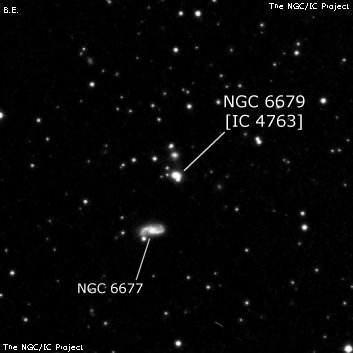
Lewis Swift discovered NGC 6679 = Sw. IX-90 on 24 Jun 1887 and described "an extremely close double with [NGC] 6679; suspected with 132, confirmed with 200; perfectly separated with 250." This was the third time he visited the field, the previous nights on 8 Jun 1885 (list I-98) and 25 Oct 1885 (list III-100). Dreyer concluded the first two numbers referred to NGC 6677, which is probably UGC 11290, the largest in the compact triplet. Swift's position for IX-90 also matches UGC 11290, but in a 1894 issue of Popular Astronomy, Swift clarified that NGC 6679 is a close double, which is a better fit with MCG +11-22-055 = PGC 62029, which has a faint star at its southwest edge.
Dreyer made an error in the declination of NGC 6679, placing it nearly 10' further north than Swift's position in list IX. Confusing the issue further is that NGC 6679 is a double system with an extremely faint component 35" north. Bigourdan made an observation on 5 Sep 1891. He couldn't find NGC 6679 at Dreyer's incorrect place, but accurately measured PGC 62029 and Dreyer recatalogued this galaxy as IC 4763. When Howe observed the field in 1899-00, he measured NGC 6677 and 6679 and described NGC 6679 as "a nebulous double star of mag 12.5, distance 5" and angle 60°. The NGC place is 8.5' out in declination." His position for NGC 6679 is an exact match with PGC 62029. So, NGC 6679 = IC 4763.
The double system UGC 11288 is misidentified as NGC 6677 + NGC 6679 in the UGC and CGCG and NGC 6677 + IC 4763 in the MCG. It doesn't appear that the northern component (MCG +11-22-056 = PGC 62026 ) was seen by Swift, Bigourdan or Howe although IC 4763 is often incorrectly assigned to this compact galaxy. Malcolm Thomson (in his unpublished "Catalogue Corrections") and Harold Corwin assign different identifications for this confusing situation.
400/500mm - 17.5" (6/11/88): fairly faint, very small, elongated SW-NE. One or two extremely faint stars are possibly involved or close off the edge. Forms a close pair with NGC 6677 1.7' SSE. MCG +11-22-056, a nearly stellar galaxy just 38" N was not seen.
600/800mm - 24" (8/27/14): fairly faint to moderately bright, small, round, 18" diameter, fairly high surface brightness. A mag 14.5 star is attached at the southwest edge.
MCG +11-22-056 = PGC 62026 lies just 0.6' N. At 375x it appeared extremely faint or very faint, round, just 8"-10" diameter. Once in my averted vision sweet spot, I could nearly hold this galaxy continuously. A mag 15 star (brighter than the galaxy) lies 0.3' NNE.
900/1200mm - 48" (10/22/11): bright, fairly small, round, high surface brightness, 20" diameter. A 14th magnitude star is attached at the southwest edge and a mag 16.5 star is 20" NE. In a close trio with NGC 6677 1.7' SSE and MCG +11-22-056 = PGC 62026 is 0.6' N. The MCG companion (identified as IC 4763 in MCG and as NGC 6679 in PGC and Megastar) appeared fairly faint, small, slightly elongated, 0.3'x0.2'. A 15th magnitude star is 18" NNE.
Zwicky described the pair (VII Zw 814) with MCG +11-22-056 as "post-eruptive blue patchy compacts interconnected by a broad uniform bridge, separation = 30" NNE-SSW."
Notes by Steve Gottlieb